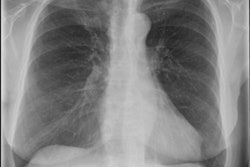A clear understanding of normal thoracic anatomy and appearances on a lateral chest radiograph, along with a systematic approach for reviewing cases, can increase confidence with interpretation, according to U.K. researchers who have developed an eight-point plan to help the process.
The lateral chest radiograph is an extremely valuable but often underused tool for clarifying equivocal abnormalities observed on the frontal chest radiograph, noted Dr. Sophie McGlade and colleagues from the Peninsula Radiology Academy at Plymouth Hospitals National Health Service Trust.
Despite advances in CT and plain film -- including digital tomosynthesis, dual-energy subtraction, and bone suppression -- the lateral chest radiograph remains a powerful tool for problem-solving when used appropriately and should not be assigned to the annals of history, McGlade told delegates at the U.K. Radiological Congress, held in Manchester last month.
"The rise in alternative imaging for follow-up of abnormalities observed in the frontal chest radiograph has, for some trainees, resulted in a lack of familiarity with the lateral check radiographs and perpetuates the underutilization and underrecognition of its value," she pointed out.
Keen to reunite radiologists and radiographers with the tools to accurately interpret the lateral chest radiograph and to demonstrate the anatomical structures that may be appreciated on a normal study, the Plymouth team has developed the following eight-point strategy:
- Check the patient details and date of the scan.
- Briefly look over the entire image to check for adequacy (true lateral versus rotated, for the entire chest, including apices and hemidiaphragms) and obvious abnormalities.
- Follow the contours of the lungs, lung markings, and diaphragm to assess the size of the lungs and estimate lung volume. Low lung volume is likely to represent pathology, the lung markings may be more easily seen on lateral rather than frontal views, and a flatter diaphragm may indicate raised residual volume.
- Trace the airways from the neck to the hilum.
- Identify the key hilar structures: the left main bronchus and the left and right pulmonary arteries). Check the inferior hilar window; opacification may indicate pathology such as inferior hilar mass or adenopathy.
- Look for darkening of the three clear spaces: the spine sign (while looking down the spine, check each vertebral body until crossing the diaphragm), the retrosternal/anterior clear space, and the retrocardiac clear space (also check the edge of the left ventricle and middle of the heart up toward the trachea).
- Look at the peripheries of the film and check the thoracic inlet, anterior chest wall, upper abdominal bowel gas, costophrenic angles, and posterior ribs.
- Correlate findings with other available imaging.
This strategy was adapted from an article by Dr. David Fiegin in Academic Radiology (December 2010, Vol. 17:12, pp. 1560-1566), McGlade stated.
Typically, a lateral chest radiograph is taken with the side of interest closer to the film, or, if no side is specified, a left lateral usually is obtained, giving less magnification of the heart, she explained. The image is labeled left or right, depending on which side was closer to the plate. The effective dose of a lateral chest radiograph is about 0.05 mSv, while a frontal chest radiograph is approximately 0.02 mSv.
"Both hemidiaphragms should be visible as domes silhouetting the gas-filled lungs above from the denser abdominal contents. The left hemidiaphragm may be distinguished from the right hemidiaphragm by loss of distinction of the anterior left hemidiaphragm against the heart or the presence of an underlying gastric bubble," McGlade noted. "Additionally, if one hemidiaphragm inserts into more magnified ribs further from the film plate, this can help with identification."
The lung fissures are visible when the x-ray beam passes through the region of interest. The left oblique fissure is steeper than that on the right, and the horizontal fissure passes anteriorly from the hilum separating the right upper and middle lobes, she continued.
The posterior border of the heart is formed by the left atrium and ventricle, while the anterior border is formed by the right ventricle. The vertebral bodies should demonstrate the so-called spine sign, and the lucency of the thoracic vertebrae should appear to increase down the spine as the volume of overlying soft tissues and bone of the chest wall reduce. The scapulae blades are usually visible, McGlade concluded.



















